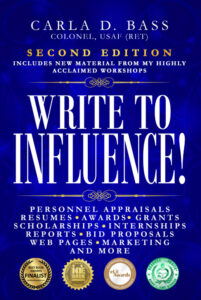Write to Influence! — Strategies
Guest blog by Carla D. Bass, Colonel, USAF (Ret), published by Women’s National Book Association
I open with three truisms: 1) The sun rises and sets 2) Nothing is certain but death and taxes and 3) My  own invention … Writing is constrained by time and space. Whether writing fact or fiction, the reader’s time and attention are fleeting … measured in seconds. Physical space is also often limited. You must engage and retain the reader’s attention with writing that is clear, concise, and compelling. Morale — The person who best leverages time and space usually wins. How? Apply Write to Influence! strategies.
own invention … Writing is constrained by time and space. Whether writing fact or fiction, the reader’s time and attention are fleeting … measured in seconds. Physical space is also often limited. You must engage and retain the reader’s attention with writing that is clear, concise, and compelling. Morale — The person who best leverages time and space usually wins. How? Apply Write to Influence! strategies.
Powerful writing correlates directly to success, personal and professional. It opens doors to opportunity that would otherwise remain closed. Accordingly, I have two battle cries. First, “Powerful writing changes lives!” Because, it does! You could be the best qualified for that job, promotion, scholarship, etc. However, if the competition is better at writing … presents a more influential case … you lose.
Second, “Powerful writing is the lifeblood for effective organizations.” It is a critical leadership skill and central to the success of private business; corporations; scientific, engineering, academic, and governmental organizations; non-governmental organizations; and authors publicizing their books! People, businesses, and organizations want and deserve to succeed but often fail. Why? The inability to communicate effectively — to positively influence the audience — constrains them.
Give me your elevator speech — Make your case in 90 seconds; provide input to your performance review in 1,000 spaces; describe your book in 25 words. You might also be required to:
- Solicit business or respond to a client’s request
- Post info on a web site to sell product or attract talented applicants
- Develop a presentation to represent your company
- Write a grant request
- Compose a bid for a contract
- Compete for research funds
What do these have in common? You must influence the reader. How? Make each word count and every second play to your advantage. How? Write powerfully.
As I explain in my “Write to Influence!” workshops, based on my book of the same name, powerful communication consists of two elements: 1) Strategies to make your case and 2) Word Sculpting Tools to hone the draft and focus the message (I’ll address in my next blog). I offer ten Write to Influence! strategies to develop your message:
- Know your audience – its familiarity with the subject, mission and business needs, etc.
- Anchor your message – first write a thesis, problem statement, or define your purpose
- Frame your message — begin with an outline! (Yes, I’m yelling. Authors often skip this critical step, resulting in a rambling and ineffective product that completely fails in its intended goal)
- List foundational questions you should address
- Anticipate questions you might prompt … answer those, too
- Identify key points (the number of which depends on length of the product)
- Research the topic and gather facts … use the outline to avoid tangents
- Speak to contrary views (as appropriate), arguing your case objectively
- Include details – These add depth, contour, and dimension to the message
- Ensure the conclusion correlates to the thesis, problem statement, or stated purpose
And a bonus …
- Take a break. Walk away from the product, then tackle it a tad later. This pause rejuvenates your perspective.
Upon what do I base these observations? Experience. I served 30 years in the Air Force, retiring as a colonel (one of the few women of my generation to do so), and another 10 years working for a federal agency.
Throughout, I composed for generals, ambassadors, congressional delegations, foreign dignitaries, and other senior leaders for whom five minutes was significant — hundreds of personnel reviews, award nominations and other competitive packages, talking points, and letters for executive signature. I currently compose items sent to the White House and Congress.
My greatest achievement — developing my writing methodology, then teaching it in workshops to thousands of Air Force members for 15 years. Careers blossomed as a result – early promotion, Congressional Fellowships, acceptance into Officer Training School and other highly competitive programs – because people learned to leverage their own words.
I delight now in teaching “Write to Influence!” workshops to a variety of audiences ranging from professionals in the workplace to high school students (focusing on essays for college applications). Next week … Word Sculpting Tools to hone that initial draft!

